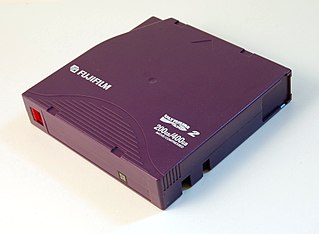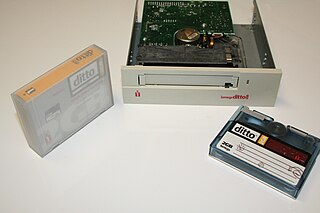
Disk storage is a general category of storage mechanisms where data is recorded by various electronic, magnetic, optical, or mechanical changes to a surface layer of one or more rotating disks. A disk drive is a device implementing such a storage mechanism. Notable types are the hard disk drive (HDD) containing a non-removable disk, the floppy disk drive (FDD) and its removable floppy disk, and various optical disc drives (ODD) and associated optical disc media.

Magnetic tape is a medium for magnetic recording, made of a thin, magnetizable coating on a long, narrow strip of plastic film. It was developed in Germany in 1928, based on magnetic wire recording. Devices that record and playback audio and video using magnetic tape are tape recorders and video tape recorders respectively. A device that stores computer data on magnetic tape is known as a tape drive.

A tape drive is a data storage device that reads and writes data on a magnetic tape. Magnetic tape data storage is typically used for offline, archival data storage. Tape media generally has a favorable unit cost and a long archival stability.

Tandberg was an electronics manufacturer located in Oslo, Norway and New York City, United States. The company began in the radio field, but became more widely known for their reel-to-reel tape recorders as well as cassette decks and televisions. The original company went bankrupt in 1978 after a sharp financial downturn. The following year, the company re-formed whilst their data division was split off as Tandberg Data, including the tape recording division, which reduced its scope to data recording.
Tandberg Data GmbH is a company focused on data storage products, especially streamers, headquartered in Dortmund, Germany. They are the only company still selling drives that use the QIC and VXA formats, but also produce LTO along with autoloaders, tape libraries, NAS devices, RDX Removable Disk Drives, Media and Virtual Tape Libraries.

A tape head is a type of transducer used in tape recorders to convert electrical signals to magnetic fluctuations and vice versa. They can also be used to read credit/debit/gift cards because the strip of magnetic tape on the back of a credit card stores data the same way that other magnetic tapes do. Cassettes, reel-to-reel tapes, 8-tracks, VHS tapes, and even floppy disks and modern hard drive disks all use the same principle of physics to store and read back information. The medium is magnetized in a pattern. It then moves at a constant speed over an electromagnet. Since the moving tape is carrying a changing magnetic field with it, it induces a varying voltage across the head. That voltage can then be amplified and connected to speakers in the case of audio, or measured and sorted into ones and zeroes in the case of digital data.

Digital Linear Tape is a magnetic tape data storage technology developed by Digital Equipment Corporation (DEC) from 1984 onwards. In 1994, the technology was purchased by Quantum Corporation, who manufactured drives and licensed the technology and trademark. A variant with higher capacity is called Super DLT (SDLT). The lower cost "value line" was initially manufactured by Benchmark Storage Innovations under license from Quantum. Quantum acquired Benchmark in 2002.

Quarter inch cartridge tape is a magnetic tape data storage format introduced by 3M in 1972, with derivatives still in use as of 2016. QIC comes in a rugged enclosed package of aluminum and plastic that holds two tape reels driven by a single belt in direct contact with the tape. The tape was originally 1⁄4 inch (6.35 mm) wide and anywhere from 300 to 1,500 feet long. Data is written linearly along the length of the tape in one track, or written "serpentine", one track at a time, the drive reversing direction at the end of the tape, and each track's data written in the opposite direction to its neighbor. Since its introduction, it has been widely used, and many variations exist. There is a QIC trade association that publishes QIC standards which include interfaces and logical formats. To a very large extent it was the efficiency and openness of this organization which encouraged hardware and software developers to use this type of drive and media.

Linear Tape-Open (LTO) is a magnetic tape data storage technology originally developed in the late 1990s as an open standards alternative to the proprietary magnetic tape formats that were available at the time. Hewlett Packard Enterprise, IBM, and Quantum control the LTO Consortium, which directs development and manages licensing and certification of media and mechanism manufacturers.

Travan is an 8 mm magnetic tape cartridge design developed by the 3M company, used for the storage of data in computer backups and mass storage. Over time, subsequent versions of Travan cartridges and drives have been developed that provide greater data capacity, while retaining the standard 8 mm width and 750' length. Travan is standardized under the QIC body. HP Colorado, Iomega DittoMax and AIWA Bolt are proprietary versions of the Travan format.

The Ditto drive series was a proprietary magnetic tape data storage system released by Iomega during the 1990s. It was marketed as a backup device for personal computers.

Exabyte Corp. was a manufacturer of magnetic tape data storage products headquartered in Boulder, Colorado, United States. Exabyte Corp. is now defunct, but the company's technology is sold by Tandberg Data under both brand names. Prior to the 2006 demise, Exabyte offered tape storage and automation solutions for servers, workstations, LANs and SANs. Exabyte is best known for introducing the Data8 (8mm) magnetic tape format in 1987. At the time of its demise, Exabyte manufactured VXA and LTO based products. The company controlled VXA technology but did not play a large role in the LTO community.

VXA is a tape backup format originally created by Ecrix and now owned by Tandberg Data. After the merger between Ecrix and Exabyte, VXA was produced by Exabyte Corporation. On November 20, 2006, Exabyte was purchased by Tandberg Data that has since stopped further development of the format.
The DC100 tape format and drive was developed by Hewlett-Packard and introduced as a data storage mechanism for the HP-9825 programmable calculator. The DC100 tape cartridge was a scaled-down version of the DC300 cartridge pioneered by 3M, and represents an early version of what is now referred to as the QIC Mini Cartridge
Magnetic tape data storage is a system for storing digital information on magnetic tape using digital recording.
The BT Merlin M4000 was a Personal computer sold by British Telecom during the 1980s as part of the Merlin range of electronic machinery for businesses. It was not developed by BT but was a rebadged Logica VTS-2300 Kennet, and a completely different machine from the Merlin Tonto which was a rebadged ICL OPD. Merlin M4000 was designed as a general purpose computer but was not IBM PC compatible, and so could not run the major business applications around at the time as these were tied to the IBM PC hardware.
The Linear Tape File System (LTFS) is a file system that allows files stored on magnetic tape to be accessed in a similar fashion to those on disk or removable flash drives. It requires both a specific format of data on the tape media and software to provide a file system interface to the data.

The Apple Tape Backup 40SC is an external, SCSI-interfaced, 1⁄4-inch (6.35 mm) QIC, mini-cartridge tape drive. It was first introduced by Apple, Inc. in 1987 and discontinued in 1994. The drive came bundled with Retrospect backup software. The drive is also compatible with the tape software included with A/UX.

D/CAS (Data/CASsette), also known as a streamer cassette, is a now-obsolete data backup technology that used an upgraded version of the common audio cassette tape and a specialized tape drive derived from an audio tape transport. Holding anywhere from 200 to 600 megabytes, it was superseded by newer data backup formats such as Travan, QIC, DDS, and LTO.













